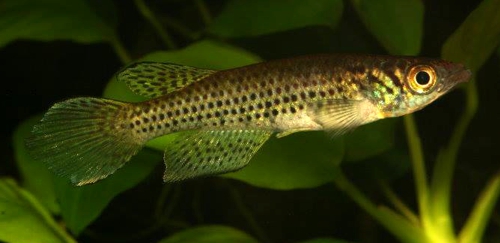Epiplatys neumanni Berkenkamp 1993

E. neumanni BDBG
07/4
Photo courtesy of Heinz Ott
| Meaning of Name |
After Dr. Werner Neumann. |
| First Description |
Berkenkamp H.O. 1993. Wiederbeschreibung des Sangmelima-Hechtlings, Epiplatys sangmelinensis (Ahl 1928) aus Ost-Kamerun, mit der Beschreibung von Epiplatys neumanni spec. nov. aus dem Ivindo-Becken von Nord Gabun. Wissenschaftliche Publikationen aus dem Referat Fischbestimmung des VDA-Bezirks 25, Weser-Ems, 1993 (1): p 1-20, figures, map. |
| Size |
63 mm |
| Meristics |
|
| Karyotype |
|
| Sub-Genus |
|
| Group |
|
| Synonyms |
|
Populations
|
|
| Type Locality |
The village of Latta located 17 km northeast of Makokou on the road to Mékambo, Province of Ogooué-Ivindo, northern Gabon. This location GWW 86 / 2. Berkenkamp also used preserved specimens from collections by Heinemann, Lenz, Pap, Harz & others in his description. |
| Distribution |
Fairly widespread. They have been found in the Ivindo Basin, the middle Ntem River, upper reaches of the Dja River, some northern tributaries of the Ogowe River (north & northeastern Gabon). The extreme northwest tip of Congo extending into southern Cameroon & eastern Equatorial Guinea. http://homepage.uibk.ac.at/homepage/c102/c102mr/epiplaty/neumanni.htm |
| Habitat |
Usually found in rainforested areas where they inhabit creeks & small bodies of water. |
| Distinguishing Characteristics | Before this species was described it was often confused with E.sangmelinensis which is a longer, more slender fish. E.neumanni has more pronounced vertical bands on the body. Berkenkamp in the description of E.neumanni stated that the two species could be seperated by the pattern of frontal neuromasts & the colour pattern of the throat. |
| Colour/Pattern Variability | |
| History |
Collected by - |
| Breeding Notes |
Not often seen. Reports suggest they are a shy & difficult species. They have been bred in a tank containing a bottom layer of peat. Lighting should be subdued. For such a shy species it would probably be advisable to cover the front of the tank with a towel or brown paper. Eggs were found in the top mop & in the peat although these would be difficult to find. Not a prolific species. Water incubation takes 12-16 days. Fry are capable of taking newly hatched brine shrimp. Growth rate is regarded as moderate with sexual maturity being attained about 6-7 months. J.P.Vandersmissen in BKA newsletter No.375, December 1996 reported breeding them in a tank furnished with plants & bogwood with a spawning mop. Water temperature 23°C, pH 6·7, GH 5. Eggs were collected halfway up the tank in the mop & Java moss. Water stored eggs hatched in 18 days. Sex ratio in this species favoured males with 100% males. Neumann found 48 out of 50 raised fish were males. |
| Diameter of Egg | 1·2 mm. |
| Remarks |
With further research E.neumanni may be re-classified as a subspecies of E.sangmelinensis. |